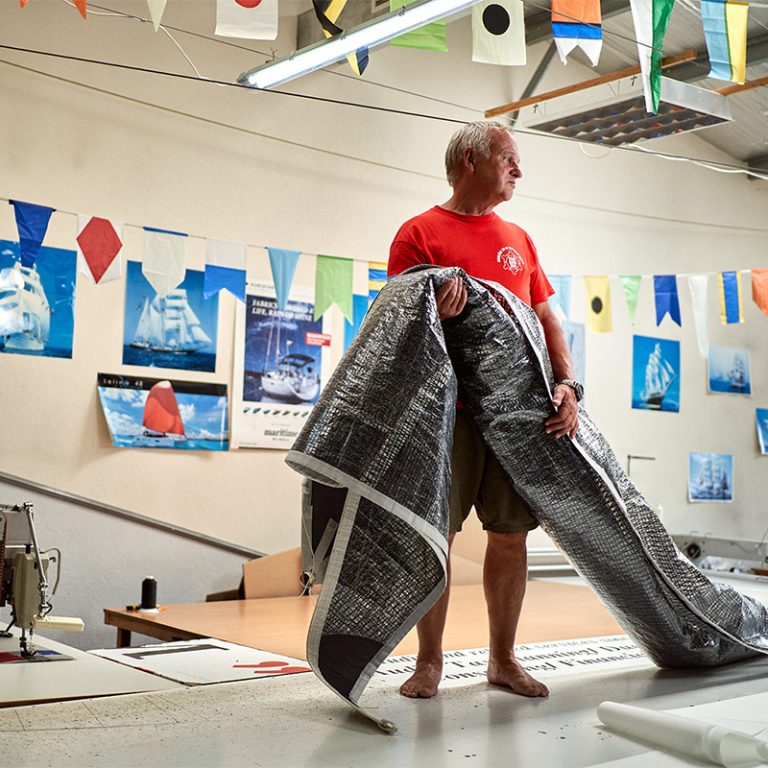Yachting in Ukraine has long been not only a maritime thing. The Dnipro river is also a perfect place for the development of sailing and ecotourism. Today, on the Dnipro, there are numerous yacht clubs, sailing schools, and traditional annual regattas. Regattas are sports races under a sail during which yachtsmen carefully study the natural resources of the water area, ‘cooperate’ with the wind, and challenge their abilities.
The trend for yachting, or sailing, in Ukraine began in the second half of the 19th century when the first yacht clubs were founded in Kyiv, Kherson, Odesa, and Mykolaiv. At first, it was exclusively an aristocratic sport but after the October revolution and Soviet power establishment, all these luxury yachts were requisitioned.
Sailing became mainstream in the 1960s. It developed at the same time as an Olympic sport (Ukrainian yachtsmen were the only ones from the former Soviet republics to win gold and bronze at the Olympic Games) and as a hobby for some enthusiasts, and later, in independent Ukraine already, as a business. Gradually, new yacht clubs were being opened, private sailing schools were recruiting students, and yacht sailmaking workshops were receiving orders.
The rise of sailing on the Dnipro river also contributes to the development of environmentally conscious tourism where the river and nature on its banks are the main natural resources that are interesting to study and important to preserve. The heroes of this story talk about this as well as the history and modernity of Ukrainian yachting.

Sewing sails. Vasyl Kiriienko
Vasyl Kiriienko, a yachtsman and owner of the K-Sails sailing workshop in Kyiv, has been making sails for yachts since the early 1990s. He has been fascinated with sailing since the late 1960s when he first joined the sailing section of the Kyiv Palace of Pioneers.
Vasyl talks about some secrets of such a seemingly archaic craft as sailmaking which is now a very modern technology with 3D design. The sail production process begins with measuring the boat’s spar to understand what size of the sail is needed. Next, a three-dimensional design of the sail is made, the fabric is laid out on a cloth which is cut on a plotter, and then assembled. At first, fabric pieces are assembled in the panel, then panels are assembled, and accessories are placed. That’s it, the sails are ready.
Spar
Round wooden beams and steel pipes that are part of the ship's equipment and are designed for carrying sails, signal lights, antennas, etc.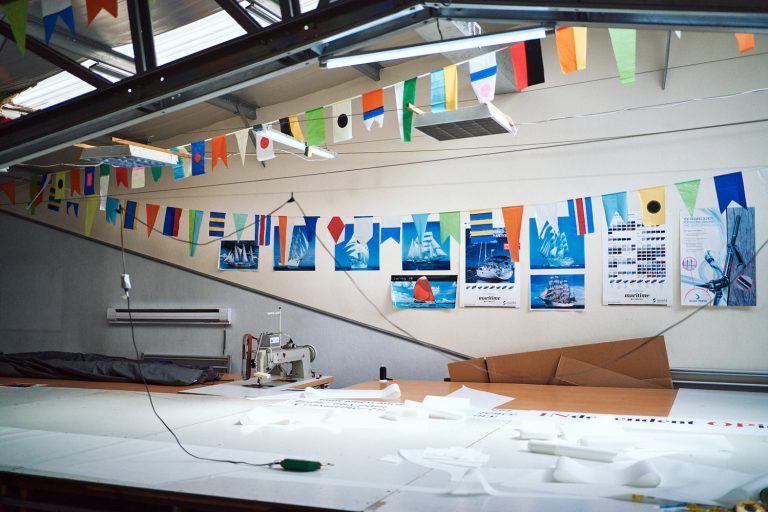
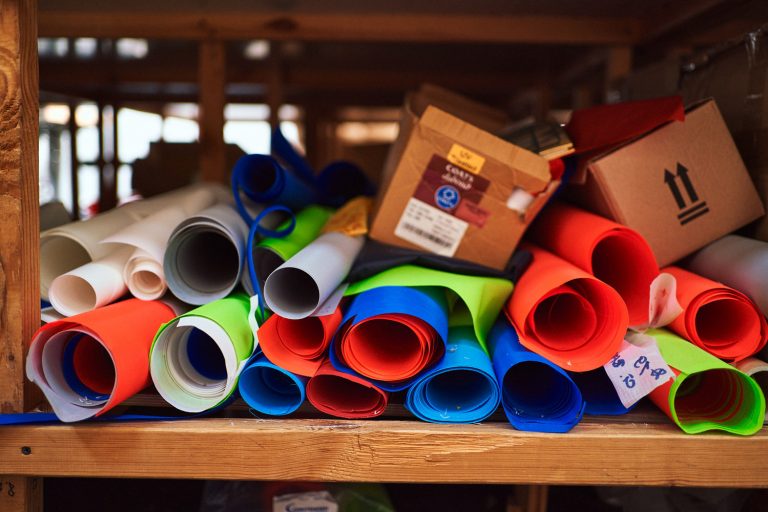
slideshow
Vasyl Kiriienko orders fabric for sails abroad. He says that the most popular manufacturers of fabrics for sails are Contender (Netherlands), Dimension Polyant (Germany), as well as Bainbridge and Challenger (USA).
Vasyl recalls that back in the ‘90s, his production began almost entirely handmade:
“At first, I drew sails on a kuhlmann (drawing board — ed.), took it off, made a cloth layout, and then painted these fabric pieces on the cloth. Later, I mastered the AutoCAD program and started making designs. I would make a layout, give it to Svieta, and she would proceed (we used to call her Svieta-plotter) with making the layout of all the fabric pieces on the cloth.”
Today, producing one sail in Vasyl Kiriienko’s workshop takes from one day to several weeks if the sails are large and heavy.

“I started sailing in 1968 when I saw yachts on Trukhanov Island. I was on my way from the training at the Dynamo Stadium, going out at the Dnipro metro station where I got on a bus to go to the left bank. There was no subway bridge back then. I saw the yachts and got interested, then I went to the island, found this section and the Palace of Pioneers (there was their base there and it is still there now). And I began to practice. And then we were training, taking part in competitions, and travelling. After the army, I went to study at a sewing school, and then to work in a studio.”
The demand for sails, says Vasyl, has revived in independent Ukraine since 1993 when the Ukrainian sailboat Hetman Sahaidachnyi was built. It took part in the Whitbread regatta around the world (known as The Ocean Race since 2019). During the construction of the sailboat, associated yacht construction centres were being established such as the Alexander Yachts company in Kharkiv, as well as workshops for sewing sails, such as Vasyl’s K-Sails.
Vasyl Kiriienko regularly participates in regattas and without sailing, he admits, he can no longer think about his life:
“Sailing is like a drug: you try it once, you like it, and that’s it. Then you can’t leave. There is no way you can disappear for a few years, and then something comes to your mind and you return. From a certain point on, this is such a lifestyle, apparently.”

The K-sails workshop offers a big discount to students of children’s sailing schools because, as Vasyl says, they are not able to provide all students with boats and sails at the moment. So it becomes the responsibility of the parents.
“We have taken this rule for ourselves: the price of our sail depends only on the cost of fabric and accessories. And it happens often that we don’t even take the accessories into account and make them for free for children to somehow support. Now we can afford it because we make money on cruising sails, and for children, we try to make sails cheaper so that it is not so burdensome for parents.”
If there is an entire sailing workshop in Kyiv loaded with work, there is probably a demand for sails. And it means that even so far from the sea there is sailing.

Ukrainian yachtsmen. Old and new schools
Ukrainian yachtsmen are divided into two schools. The old school, still a Soviet one, knew the numbers of all the buoys on the Dnipro. And until 1991, it could only dream madly of going abroad, at least to Bulgaria. The new school passed along Korchuvate to Ukrainka for the first time only due to the quarantine in 2019, and so it knows the waters of the Aegean and Adriatic seas much better than the Kaniv Reservoir.
The old school built the yachts on its own according to drawings from the ‘Boats and Yachts’ Soviet magazine published since 1963. The yachts were being built for years, the necessary materials were being noted down or taken out at night from the Leninska Kuznia plant or the Kyiv Shipbuilding and Ship Repair Plant. All over the world, yachts were built of wood, plastic or metal. Soviet yachtsmen, at the time of the general shortage of everything, began to produce yacht hulls from ferro-cement instead of wood or fibreglass.
A new school usually takes yachts on a charter somewhere in Tahiti or the Canary Islands and often doesn’t even know what is timber called in Ukrainian (timber is a wooden beam from which frames are bent). Its representatives have not seen any drawings in the ‘Modeler-constructor’ magazine, and received captain licenses abroad and passed their exams in English.
Charter
Agreement between the owner and the lessee on the lease of a vessel for a certain period.The old school, barely given the opportunity, rushed to go around the world on their yachts and participate in the Whitbread race around the world. The new school is better versed in ticket prices, low-cost flights, and connecting flights than in the trade winds of the Atlantic and Pacific Oceans. Like, let’s fly and then deal with it on spot. But they only travel having bought return tickets. The old school representatives have seen dozens of different types of yachts in the last few years as if it were an endless test drive, and now they compare catamarans and trimarans with proper knowledge.
Catamaran and trimaran
A vessel with two (for a catamaran) and three (for a trimaran) parallel hulls connected in the surface part.
Serhii Polishchuk, the first vice-president of the Sailing Federation of Ukraine and editor-in-chief of Skipper magazine, is an old-school yachtsman. He started sailing in Soviet times in the sailing section of the Kyiv Palace of Pioneers. He was among the students of Serhii Mashovets who at that time had already trained the famous yachtsman Valentyn Mankin, a three-time Olympic champion. Mankin began his career in sailing on Dnipro, then studied at the Kyiv Civil Engineering Institute while training behind the dam in Vyshhorod and competing for the USSR.
Only the old school before the war could have thought of going to the German port of Kiel on the Volga via Nizhny Novgorod, and not by sea via Gibraltar. And then to tour the Baltic and the North Sea for years, earning money on tourists on their own, not a rented yacht. And then the yachtsmen of the old school always feel nostalgia and inevitably return to Dnipro, to the home yacht club.

Regatta. Serhii Polishchuk
In May 2021, on the eve of Kyiv Day, the traditional annual sailing regatta was held on Dnipro. This time it began on the Podil embankment, near the chapel of St. Nicholas the Wonderworker. The participants of the regatta gathered for a short briefing before the race.
“After the start, you should bypass the striped 148th (the sequence number of the buoy — ed.) on the port side and go down to the 153rd. A blue inflatable rubber cube will be present in front of the 153rd. Then go through the gate, i.e. you can bypass the black 153rd on the starboard side or the inflatable cube on the port side. Then go through the starting line again, go to the 148th, turn, and finish.”
On the river, all buoys are numbered from the dam upstream. This year, the regatta which has been held since 1995 involves 18-20 yachts. They are going to be divided into divisions by size, and the winner will be determined by a computer.
“When they see sails on our blue Slavutych, everyone who knows the community says: ‘How wonderful that we have sailing in Kyiv!’ Today, most of the teams are from Kyiv. But usually, some teams also come from Slavutych, Cherkasy, and Pereiaslav. That is, our geography is quite wide.”

Usually, all regattas start with the registration of vessels: the relevant documents on the yacht and crew qualifications are submitted, participation fees are paid, if any. When all the boats have been registered, all the documents are drawn up and applications are submitted. Everything is very responsible because there are safety concerns. Participants must also provide a certificate of technical inspection of the yacht confirming that all life-saving equipment is in order and not overdue.
At the competition, there is a chairman of the race committee who is responsible for conducting the regatta. There is also the chairman of the organising committee, the chairman of the regatta bureau, and the measurer. When registration is complete, the main measurer usually announces a list of groups in cruising competitions.
“All boats here are different, and they all have a measuring certificate to maximise their racing chances. There are small, medium-sized, and large boats all grouped individually. Although they start together, the overall rating is separate.”
The Kyiv Day regatta consists of two windward and leeward distances (starting against the wind) between Podilsko-Voskresenskyi and Pedestrian Bridges and one route starting at the Podil River Port and finishing at the Osokorky City Cruising Yacht Club. After going beside the upper sign, the distance goes downwind to the lower sign. Then the crews put additional sails: spinnakers and gennakers. Yacht crews follow the sailing instructions, a document that defines the distance, how many times and how exactly you need to go beside the signs, i.e. the order of going beside.
Spinnakers, gennakers
Large sails that are set when the yacht goes with the accompanying wind. As a rule, they are variegated and individually painted and make the regatta look beautiful.The yachts manoeuvre, get together, flutter their sails, drift so as not to cross the starting line between the judge’s vessel Perun and the marked buoy earlier than the specified time The Papa flag is raised on the judge’s boat, and in a few minutes, at exactly 11 a.m., the flag is lowered, which means that the start has been announced. Yachts one by one choose their sheets and go manoeuvring zigzags against the wind to the upper buoy.
Papa flag
English signal flag letter P.Meanwhile, Captain Serhii Polishchuk tells how he started yachting at the Palace of Pioneers:
“I was 14 years old. The coach saw something in me and made me the foreman of the boat. We studied maritime. And you know, guys at this age, they trust mentors very much. So he introduced me to sailing.”
Later, there was training at the Kyiv Polytechnic Institute, and then another sailing section at the Locomotive sports society.
“The Palace of Pioneers is only my childhood and youth, and when I was 18 already, I went to Lokomotiv. And it went like this in my life. Later, I began to compete on cruising yachts. I made voyages on a Polish-built yacht Taurus: a large yacht weighing seven tons, around 11 meters long.”
The first yacht went beside the upper buoy on the starboard side. This is the Solo yacht of skipper Bohdan Blavatnyi. Now they need to ‘go down with the wind’. A colourful spinnaker was unfurled over the yacht with a parachute clap.

Captain Polishchuk continues the story about moving from Kyiv to Germany, to the city of Kiel, on the Taurus. And he was then sailing for a few years, mostly the Baltic sea, but sometimes also the North Sea because Kiel stands right at the canal that connects the two seas.
When Soviet yachtsmen came to Germany, everyone in yacht clubs took patronage over them: they would bring some juice or waterproof suits because there was no such thing in the union republics. Thus, Serhii Polishchuk gathered an entire collection of German magazines ‘Yacht’ and ‘Segelsport’ and the Polish magazine ‘żagiel’. And in a few years, he returned to Kyiv and became the editor-in-chief of the Ukrainian magazine ‘Skipper’. But the connection with sailing was not lost.
When Ukraine became independent, the Ukrainian Sailing Union was first established, which in 1997 was reorganised into the Sailing Federation of Ukraine and registered within the International Sailing Federation. Ukraine also became independent in sailing because, in Soviet times, almost half of the USSR national team consisted of Ukrainians. In 1996, Ukraine competed as an independent team for the first time at the Olympic Games. Then two Ukrainian crews won medals: Yevhen Braslavets and Ihor Matvienko — gold, and Ruslana Taran and Alyona Paholchyk — bronze. None of the former Soviet republics has won the highest Olympics awards in this sport. Ukraine was able to do that.
The conversation with Captain Polishchuk is gradually moving to whether the state should invest in high-achievement sports, and whether it is a matter of the citizens themselves, for example, parents supporting the children’s sections and universities supporting the sports clubs.
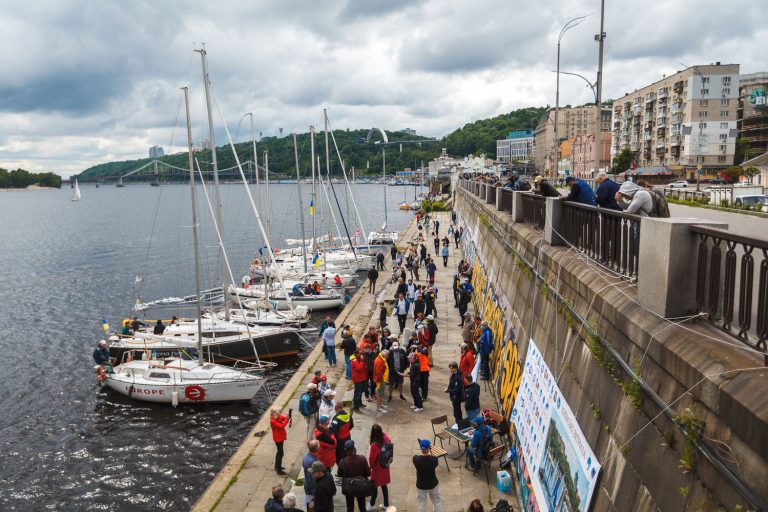
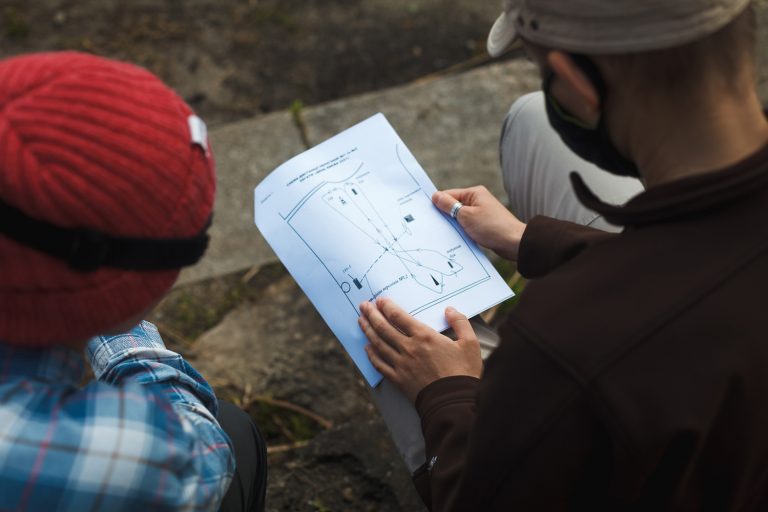
slideshow
According to Serhii Polishchuk, commercial schools that teach children sailing predominate all over the world. And then, when the children earn some medals, the state joins in to help. And in Ukrainian sailing, it works the same way.
“There is a future but it will be more about mass sports, and maybe it’s not so bad. If more social groups will be involved in this activity, then the best athletes will break through to participate in Olympic competitions. Now it is so. We now have many private schools that teach children sailing and adults too, in fact.”
Captain Polishchuk is discussing something with his helmsman Vasyl Bilenko who is also a yacht captain, where best to drop anchor. Then Serhii continues:
“In our country, cruising sailing is also at the proper level. Because Ukraine is the only country that in 1993 and 1994 put two crews on the famous Whitbread regatta around the world. One crew was a purely Ukrainian yacht Hetman Sahaidachnyi built in Kharkiv according to the project of the famous designer Bruce Far. And the second yacht, the Odesa-200, was a yacht from Odesa that was completed in the United States because there was a lack of Ukrainian funding. Nevertheless, these yachts carried our flags, they were Ukrainian, the crews were Ukrainian. No country from the post-Soviet and socialist camps was to have two crews in the race around the world twice.”
The last yachts finish near the lower buoy. Now there is another race like this, and the third is in the wind, from here to Osokorky.

Yachts and a self-made catamaran. Vasyl Bilenko
According to yachtsmen Serhii Polishchuk and Vasyl Bilenko, there is no serial production of sailing yachts in Ukraine now because there is no demand for them. And until 2008, it was done by Ukrainian yachtsman Artem Sokovnin.
“Sokovnin built yachts in series, initially small ones. They have been sold all over the world and are being sold now. Then he began the production of large yachts. They made 5 pieces, having invested in this production about 100 thousand euros. All of this lasted until the crisis of 2008.”
Of course, all this applies primarily to the Kyiv yacht building but it is obvious that similar processes were taking place in Kherson, Mykolaiv, Mariupol, and Odesa.
Yachtsman Vasyl Bilenko, who was the captain of the first Ukraїner water expedition, is currently building a catamaran on the model he once saw at an exhibition in Dusseldorf, Germany. And the construction of a catamaran, as we know, is not an action but a state that, instead of for four months, lasts for almost a year now. So Vasyl can talk about his project for hours. He says the decision was made by the whole family.
“Most yachts in Ukraine are used yachts that are imported here, albeit in good condition but they are already 5-10-15 years old. And no matter what you do with them, they will only get older. And you want to enter in and smell the new paint, wood, well, you feel it’s new. A new yacht costs 60-80 thousand euros plus it should be cleared of customs — all in all, you have to pay some crazy money. Business does not need such a yacht here, it will never make a return. So I thought: why not build a yacht yourself? There is a workshop, there are all the machines needed, there is a person with the right hands, there is a desire. And we decided to make it. And then we thought: listen, why do we need that yacht, let’s make a catamaran because there are not enough of them in Ukraine. Now, by the way, there are many more because they are in commercial demand, especially in Kyiv.”

Vasyl Bilenko is a yachtsman of a new school. He recalls how in 2009 he met a Pole at a tourist exhibition who said that it was quite easy to operate a yacht while it was still difficult to get a licence in Ukraine. It was necessary to pass first the yacht stern of the second class, then the first, then the yacht captain, that is it could stretch for years.
“And this is what I was offered: a week of practice in Croatia and you get your licence. Then you can take the yacht anywhere. I liked it. We studied the theory at his home because he had also just founded his company in Ukraine in 2009, and then he went to Croatia. And then I passed the exam there (it lasted about fifteen minutes, in the port management office) and got my first captaincy. And so it went.”
Within a month, Vasyl had put together the crew, inviting the experienced yachtsman Bohdan Brudnovskyi to join him, and under his supervision, he gained experience of sailing independently in Croatian waters. After a few years of such sailing trips with friends for the May holidays, he began to do it professionally, left the tourism business and completely immersed himself in a yacht charter.
“I went to the North Sea, we had this route Holland — France — Great Britain and back, it was a completely different experience. Then I went to the following transfers: Palma de Mallorca — Gibraltar — Madeira — Canary Islands — Cape Verde, well, in short, that area. I set myself such a task, say, to master a new direction every season. Or a new island, a new water area to see how it all happens.”
Vasyl Bilenko has been working as a journalist for tourist publications for a long time. This experience gave him a lot. He travelled to many countries and showed journalists all the nuances that are possible. He combined it with what is on the yacht. And these were not just yacht trips but cruises when you can tell your guests a lot: where there is an interesting location, a restaurant, or a beautiful bay. He began to be involved in the training of beginners, received an instructor’s license, and was trained in Poland. And since 2014, in addition to captaincy, he taught a theoretical course in Kyiv and then conducted a practice in the Mediterranean.
“At first, I didn’t actually know Dnipro. I rented a yacht in Kyiv with the captain a couple of times. It was interesting for me to go on the water. And last year, due to the quarantine, we implemented our plan. Well, not only in connection with the quarantine, we still planned to buy a yacht and bring it to Kyiv in order to do master classes on driving a yacht, in order to rent it, well, sail ourselves, and for the yacht to be profitable. This is not a secret for anyone that for us it is first of all such a mini-business.”

An unexpected consequence of the coronavirus pandemic was that the yachtsmen of the new school became excited about the inland waterways. And, well aware of what makes the Greek or Croatian archipelagos attractive for tourists, they were able to assess the tourist potential of Dnipro and the cascade of man-made seas created on it.
“You just have to go beyond Kyiv and you get into a completely different world. Very beautiful, unexpected. Most Kyiv locals or residents of Ukrainian cities have no idea what enormous opportunities we have on Dnipro, in the Kaniv Reservoir in particular.”
Vasyl Bilenko notes that the Kaniv Reservoir is the most suitable for small day transfers (because it has enough picturesque islands, straits, coves and shelters from strong winds). Kremenchuk and Kyiv, not to mention Kakhovka and Dniprodzerzhynsk reservoirs, are very spacious, the waves there sometimes really roam like the sea waves, and you can’t hide from it anywhere.
“The Dnipro River is our potential. It is extremely beautiful, especially in the reservoir. You go out on the water and get into such a natural reserve, indeed: it’s quiet around and you can only hear the croaking of frogs and the buzzing of mosquitoes that are trying to bite you. And it is only forty kilometres away from Kyiv. I believe that there should be at least fifty times as many yachts in this area at the same time because the natural conditions here allow it.”
According to Vasyl, the Kaniv Sea lacks a well-established yacht infrastructure: marinas for placing yachts at night, restaurants, hotels, shops for tourists, etc. At the same time, the wildness, the originality of nature in the waters of the Kaniv Reservoir in particular, according to the yachtsman, is the advantage that will allow the development of the Dnipro ecological tourism.
However, the infrastructure alone is not enough. Vasyl also emphasises the importance of solving the global problem of the Dnipro algae bloom and the role of the state in this process.
“The biggest problem in the Kaniv Reservoir today is ecological. The water is blooming. This will not be resolved so quickly, this is exactly where the state must take strategic steps to improve the situation. Otherwise, the water area will turn into a swamp and there will be nothing here.”
Therefore, it is hoped that the research and initiatives of Ukrainian scientists, as well as the impressions and experience gained by Ukrainian yachtsmen across three seas, will come back to Ukraine and change the local conditions for sailing and the ecological situation on Dnipro for the better.
“Ukraine is a beautiful country. We don’t have to go somewhere to work. Looking at our nature, we can be proud that we live here, that we have Dnipro.”
supported by
This material was created with the support of the Swiss embassy in Ukraine. Ukrainer is solely responsible for the content. The opinion of the material creators does not necessarily reflect the views of the donor.


